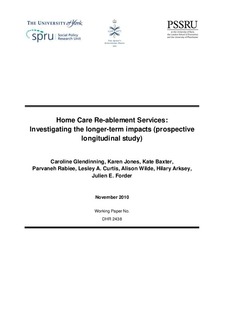| dc.identifier.citation | Glendinning, C., Jones, K., Baxter, K., Rabiee, P., Curtis, L.A., Wilde, A. & Forder, J.E. (2010) Home Care Re-ablement Services: investigating the longer-term impacts (prospective longitudinal study). Working Paper No. DHR 2438. Hentet fra: https://www.bl.uk/collection-items/home-care-reablement-services-investigating-the-longer-term-impacts-prospective-longitudinal-study | |
| dc.description.abstract | Executive summary: re-ablement is a new, short-term intervention in English home care. It helps users to regain confidence and relearn self-care skills and aims to reduce needs for longerterm support. Home care re-ablement services are usually provided or commissioned by local authorities responsible for adult social care. Some services are selective, prioritising people discharged from hospital or recovering from illness and accidents; others are more inclusive, accepting almost all those referred for home care. In autumn 2010, £70 million was allocated to NHS Primary Care Trusts for further development of re-ablement services. Further funding to the NHS for reablement is being made available as a result of the government's spending review; £150 million in 2011/12, rising to £300 million per annum over the period 2012-15. Research by the Social Policy Research Unit, University of York and the Personal Social Services Research Unit, University of Kent examined the immediate and longer-term impacts of home care re-ablement; the cost-effectiveness of the service; and the content and organisation of re-ablement services. People who received home care re-ablement were compared with a group receiving conventional home care services; both groups were followed for up to one year. According to data supplied by local authorities, the unit cost of a typical reablement episode is £2,088. The mean cost per hour is £20 and the mean cost per hour of service user contact time is £40. Re-ablement was associated with a significant decrease in subsequent social care service use. The costs of the social care services used by people in the reablement group during the 12 months of the study (excluding the costs of the reablement intervention itself) were 60 per cent less than the costs of the social care services used by people using conventional home care services. However, this reduction in social care costs was almost entirely offset by the initial cost of the re-ablement intervention. The total (including re-ablement) mean cost of the social care services used by the re-ablement group was £380 lower than the total mean cost of the social care services used by the comparison group. The re-ablement group had significantly higher healthcare costs than the comparison group during the first eight weeks of the study. However, more people in the re-ablement group had been referred to the service following discharge from hospital. These people had significantly higher healthcare costs (mainly arising from further hospital in-patient episodes) during the first eight weeks of the study than people who had been referred to re-ablement from the community. However, there was no significant difference between the reablement and comparison group in the costs of the health services used during the subsequent ten months of the study. When baseline differences were taken Home care re-ablement services: investigating the longer-term impacts into account, there were also no significant differences in the duration of inpatient stays or the total costs of healthcare service use when averaged across the two groups over the full 12 months of the study. Taking total healthcare, social care and re-ablement costs together, there was no statistically significant difference in the costs of all the services used by the reablement and comparison group over the 12 month study period. Re-ablement had positive impacts on users health-related quality of life and social care-related quality of life up to ten months after re-ablement, again in comparison with users of conventional home care services. At a „willingness to pay‟ threshold of £30,000 for each increase in health-related quality of life, there is a very high probability (99 per cent) that re-ablement is cost-effective if health and social care costs are taken into account, and just under 100 per cent probability if social care costs alone are included. At a more stringent threshold of £20,000 per health-related outcome gain, the probability of cost-effectiveness is still very high, at 98 per cent for health and social care costs and 99 per cent for social care costs only. For social care-related outcomes, at a „willingness to pay‟ threshold of £30,000 per outcome gain, there is a 78 per cent probability that re-ablement is cost-effective if both health and social care costs are included and a 98 per cent probability that re-ablement is cost-effective if just social care costs are included. At the more stringent threshold of £20,000 per social care-related outcome gain, the probability of cost-effectiveness is 68 per cent for combined health and social care costs, but still 98 per cent for social care costs only. Effective re-ablement services require good initial staff training and on-going supervision; clear outcomes for users and flexibility to adapt these as needs change; and prompt supply of equipment. Prompt transfer to home care for those who need it at the end of re-ablement is essential to maintain capacity in re-ablement services. Users and carers were positive about the impact of re-ablement on their independence and confidence, although some would have liked more help to improve their mobility and undertake activities outside the home. | |
